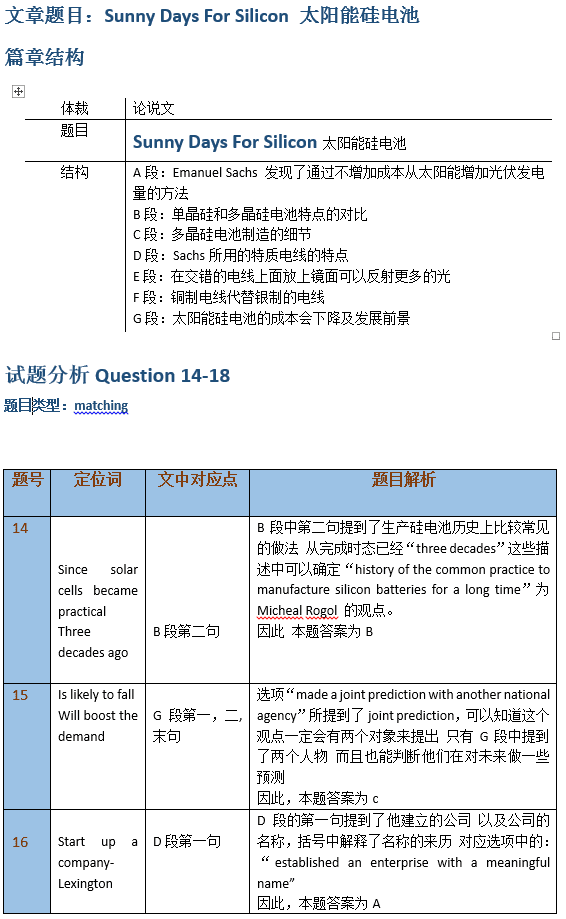如何考好gre阅读考试呢?今天小编给大家带来了gre考试阅读训练怎么办,希望能够帮助到大家,下面小编就和大家分享,来欣赏一下吧。
gre考试阅读训练怎么办
gre阅读训练方法:
在阅读和训练的过程中,gre阅读方法,gre考试培训唯一的目的是在大脑中反映英语(而不是汉语口译)的意义。当读者发现他们在阅读过程中完全消除了大脑中的汉语解释和语法分析过程时,这一要求就得到了满足
gre阅读考试训练模式:
A.心理团体训练;B.不回头训练;C.合理原则推力训练;D.速度与理解平衡点训练
GRE阅读训练模式的意义群训练:
取几个与阅读对象意思相同的相邻单词,而不是一个单词。同时,避免大声朗读,克服内心的声音和喉咙、嘴唇的震动。
第二点:
眼睛在gre考试阅读材料上比在心脏或喉咙上移动得快
GRE阅读训练模式的非回顾性训练:
为了确保第一次阅读时注意力集中,避免回头看,关键是:
第三点:
读这篇文章时,要注意整句话回头看的现象,坚持一直往下看
GRE阅读训练模式的合理化训练:
根据文中上下文的逻辑推理,我们不知道在哪里进行理性推理。
第四点:
如果你不知道地点,用理性推理来推理
GRE阅读训练模式中速度与理解的平衡点训练:
提出了速度与理解的平衡点,并根据阅读的难度和重要性调整了现场阅读的速度。
第五点:
坚持下去,不要半途而废,这很重要。
GRE阅读的突破方法:集中突破法
我先师在N次的感悟及扫遍所有市面上见到和见不到的出国考试阅读题的基础上,创出一套以此法为依托的《葵花宝典》,最终实现了上面所言之境界。集中突破法,顾名思义,就是在短时间里集中突破思维的极限达到出题人的高度去审视每道题背后的东西,从而提前迅速地围追堵截,实现阅读飞跃。
GRE阅读突破原则:10—15天,以NO题为蓝本,《难句》一书为文火培元固本,再辅以LSAT武火锤炼。但是前提是你现在已经做完所有的NO题一遍,且已经达到第三阶段的要求与现象,即在规定的时间内错题在3—5以内,规定时间是在15—18分钟内。记住:集中突破法直接决定你最后达到的阅读境界,所以一个人一生只能用一次,如果你还没有这种水平,奉劝你切勿操之过急,否则永远也达不到一个全新的高度,一定要达到第三阶段的水平再练,切记!另外,一旦开始,就不能停下,直至完成,否则前功尽弃,后果不堪设想!
GRE阅读:法国二月革命
In February 1848 the people of Paris rose in revolt against the constitutional monarchy of Louis-Philippe. Despite the existence of excellent narrative accounts, the February Days, as this revolt is called, have been largely ignored by social historians of the past two decades. For each of the three other major insurrections in nineteenth-century Paris—July 1830, June 1848, and May 1871—there exists at least a sketch of participants’ backgrounds and an analysis, more or less rigorous, of the reasons for the occurrence of the uprisings. Only in the case of the February Revolution do we lack a useful description of participants that might characterize it in the light of what social history has taught us about the process of revolutionary mobilization. Two reasons for this relative neglect seem obvious. First, the insurrection of February has been overshadowed by that of June. The February Revolution overthrew a regime, to be sure, but met with so little resistance that it failed to generate any real sense of historical drama. Its successor, on the other hand, appeared to pit key socioeconomic groups in a life-or-death struggle and was widely seen by contemporary observers as marking a historical departure. Through their interpretations, which exert a continuing influence on our understanding of the revolutionary process, the impact of the events of June has been magnified, while, as an unintended consequence, the significance of the February insurrection has been diminished. Second, like other “successful” insurrections, the events of February failed to generate the most desirable kinds of historical records. Although the June insurrection of 1848 and the Paris Commune of 1871 would be considered watersheds of nineteenth-century French history by any standard, they also present the social historian with a signal advantage: these failed insurrections created a mass of invaluable documentation as a by-product of authorities’ efforts to search out and punish the rebels.
Quite different is the outcome of successful insurrections like those of July 1830 and February 1848. Experiences are retold, but participants typically resume their daily routines without ever recording their activities. Those who played salient roles may become the objects of highly embellished verbal accounts or in rare cases, of celebratory articles in contemporary periodicals. And it is true that the publicly acknowledged leaders of an uprising frequently write memoirs. However, such documents are likely to be highly unreliable, unrepresentative, and unsystematically preserved, especially when compared to the detailed judicial dossiers prepared for everyone arrested following a failed insurrection. As a consequence, it may prove difficult or impossible to establish for a successful revolution a comprehensive and trustworthy picture of those who participated, or to answer even the most basic questions one might pose concerning the social origins of the insurgents.
12.1. According to the passage, “a useful description of participants” (lines 11-12) exists for which of the following insurrections of nineteenth-century France?
I. The July Insurrection of 1830
II. The February Revolution of 1848
III. The June insurrection of 1848
IV. The May insurrection of 1871
(A) I and III only
(B) II and IV only
(C) I, II, and III only
(D) I, III, and IV only
(E) II, III, and IV only
12.2. It can be inferred from the passage that support for the objectives of the February Revolution was
(A) negligible
(B) misguided
(C) fanatical
(D) spontaneous
(E) widespread
12.3. Which of the following, best describes the organization of the second paragraph?
(A) The thesis of the passage is stated and supporting evidence systematically presented.
(B) Two views regarding the thesis presented in the first paragraph are compared and contrasted.
(C) Evidence refuting the thesis presented in the first paragraph is systematically presented.
(D) The thesis presented in the first paragraph is systematically supported.
(E) The thesis presented in the first paragraph is further defined and a conclusion drawn.
12.4. It can be inferred from the passage that the author considers which of the following essential for understanding a revolutionary mobilization?
(A) A comprehensive theory of revolution that can be applied to the major insurrections of the nineteenth century
(B) Awareness of the events necessary for a revolution to be successful
(C) Access to narratives and memoirs written by eyewitnesses of a given revolution
(D) The historical perspective provided by the passage of a considerable amount of time
(E) Knowledge of the socioeconomic backgrounds of a revolution’s participants
12.5. Which of the following can be inferred about the “detailed judicial dossiers” referred to in line 49?
(A) Information contained in the dossiers sheds light on the social origins of a revolution’s participants.
(B) The dossiers closely resemble the narratives written by the revolution’s leaders in their personal memoirs.
(C) The information that such dossiers contain is untrustworthy and unrepresentative of a revolution’s participants.
(D) Social historians prefer to avoid such dossiers whenever possible because they are excessively detailed.
(E) The February Revolution of 1848 produced more of these dossiers than did the June insurrection.
12.6. Which of the following is the most l.ical objection to the claim made in lines 38-39?
(A) The February Revolution of 1848 is much less significant than the July insurrection of 1830.
(B) The backgrounds and motivations of participants in the July insurrection of 1830 have been identified, however cursorily.
(C) Even less is known about the July insurrection of 1830 than about the February Revolution of 1848.
(D) Historical records made during the July insurrection of 1830 are less reliable than those made during the May insurrection of 1871.
(E) The importance of the July insurrection of 1830 has been magnified at the expense of the significance of the February Revolution of 1848.
12.7. With which of the following statements regarding revolution would the author most likely agree?
(A) Revolutionary mobilization requires a great deal of planning by people representing disaffected groups.
(B) The objectives of the February Revolution were more radical than those of the June insurrection.
(C) The process of revolutionary mobilization varies greatly from one revolution to the next.
(D) Revolutions vary greatly in the usefulness of the historical records that they produce.
(E) As knowledge of the February Revolution increases, chances are good that its importance will eventually eclipse that of the June insurrection.
gre考试阅读训练怎么办相关文章:
★ GRE数学备考如何冲刺高分满分
★ GRE阅读高频题型训练注意事项
★ 中学生课外阅读题训练附答案
gre考试阅读训练怎么办
上一篇:gre考试长难句怎么读懂
下一篇:gre考试阅读提分需要什么






